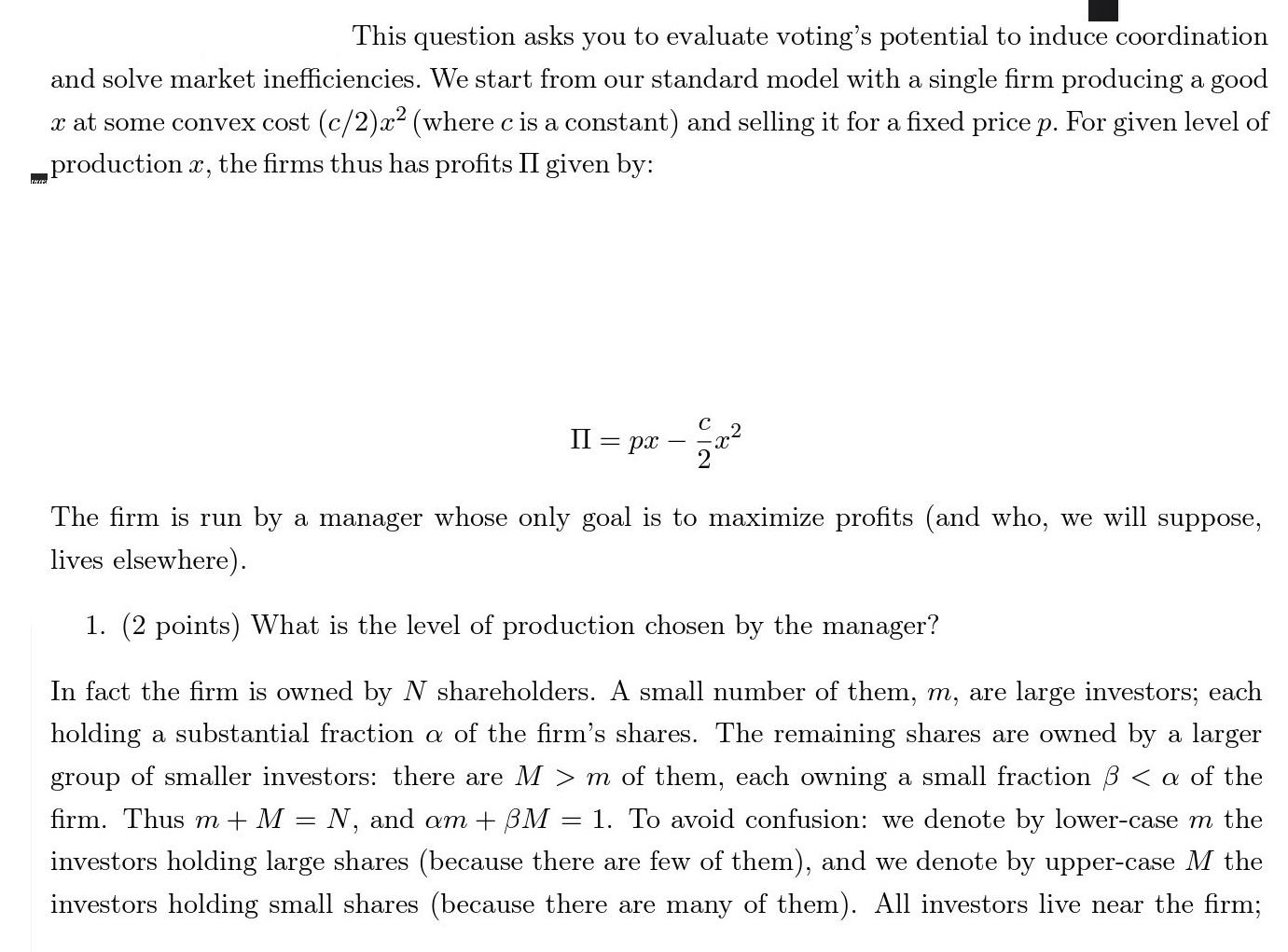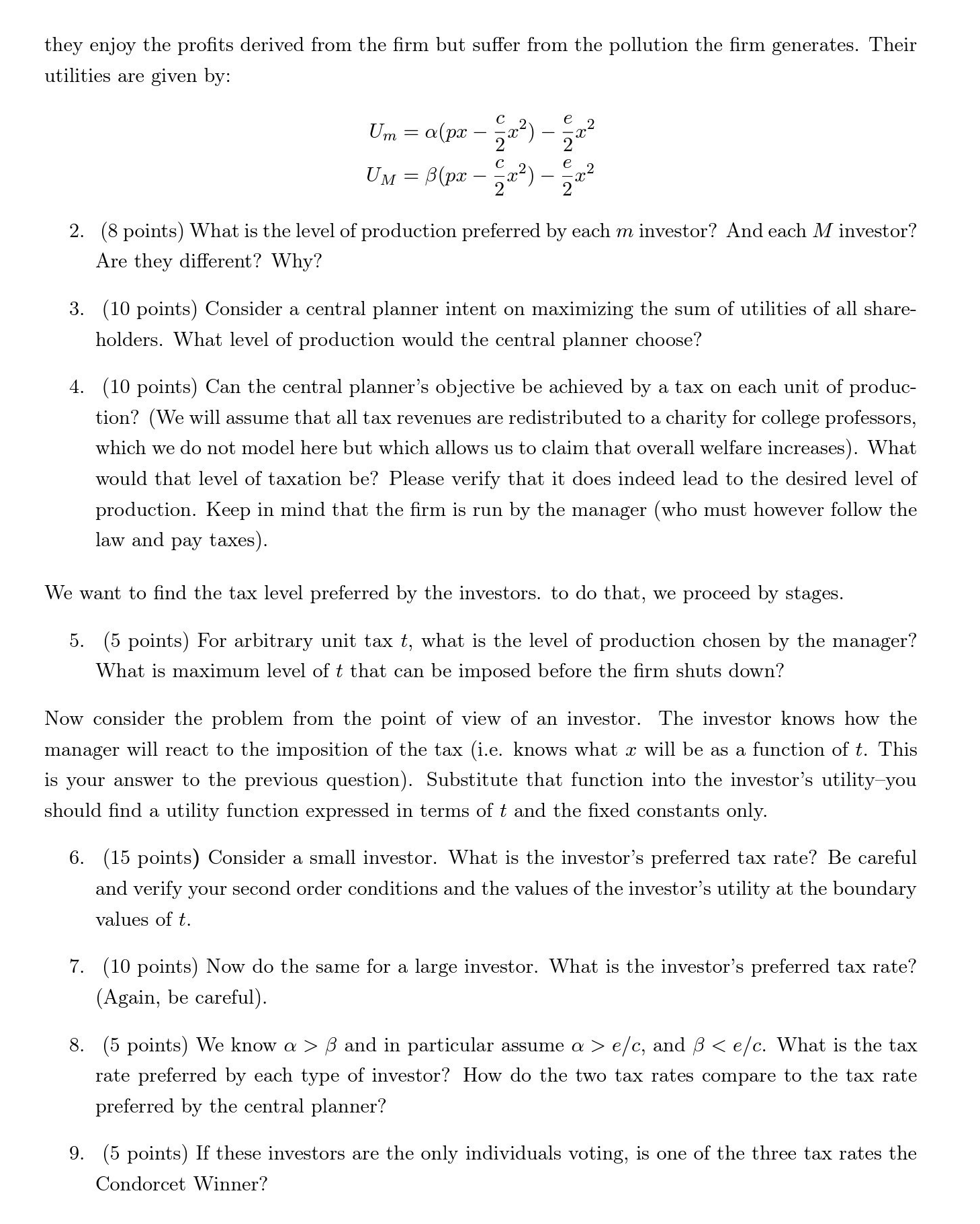Answered step by step
Verified Expert Solution
Question
1 Approved Answer
This question asks you to evaluate voting's potential to induce coordination and solve market inefficiencies. We start from our standard model with a single



This question asks you to evaluate voting's potential to induce coordination and solve market inefficiencies. We start from our standard model with a single firm producing a good x at some convex cost (c/2)x2 (where c is a constant) and selling it for a fixed price p. For given level of production x, the firms thus has profits II given by: C II = px - The firm is run by a manager whose only goal is to maximize profits (and who, we will suppose, lives elsewhere). 1. (2 points) What is the level of production chosen by the manager? In fact the firm is owned by N shareholders. A small number of them, m, are large investors; each holding a substantial fraction a of the firm's shares. The remaining shares are owned by a larger group of smaller investors: there are M > m of them, each owning a small fraction 10. (10 points) Suppose now that an idealistic band of new residents arrive, of size K. They do not own shares in the firm and are not related to the local citizens, but because they are idealistic these new residents' preferred position coincides with the central planner's position. They have the right to vote. Does the set-up of the problem guarantee that among the three tax rates under consideration one must continue to be the Condorcet winner? Why? 11. (5 points) Does the Condorcet winner depend on K? How? Suppose that K = 40, M = 40, m = 20. There is a vote on the tax rate and ballot consists of the three tax rates we have been considering. It is decided that voting will follow the Borda rule (each voter give 3 points to their preferred alternative, 2 to the second favorite, and 1 to the least preferred). We will assume that the idealist group prefers the tax rate advocated by the small investors over the one preferred by the large investors. 12. (5 points) Which tax rate wins if voters vote sincerely? 13. (10 points) Is there an incentive for any of them to lie? 14. (5 points) Would such an incentive exist if voting followed "true majority" (or the Condorcet rule), with each alternative pitted against each of the two others? Among the desirable properties of voting rules listed by Arrow, which one is satisfied by "true majority" but not by Borda? 15. (5 points) Is there a general result (a theorem) in voting theory that could have led you to expect the answer you found in 13. above? And if your answer to 14. above differs, why does the general result that explains 13. not apply to 14.? they enjoy the profits derived from the firm but suffer from the pollution the firm generates. Their utilities are given by: Um = a (px - x) UM = (px - x) 22)-222 2. (8 points) What is the level of production preferred by each m investor? And each M investor? Are they different? Why? 3. (10 points) Consider a central planner intent on maximizing the sum of utilities of all share- holders. What level of production would the central planner choose? 4. (10 points) Can the central planner's objective be achieved by a tax on each unit of produc- tion? (We will assume that all tax revenues are redistributed to a charity for college professors, which we do not model here but which allows us to claim that overall welfare increases). What would that level of taxation be? Please verify that it does indeed lead to the desired level of production. Keep in mind that the firm is run by the manager (who must however follow the law and pay taxes). We want to find the tax level preferred by the investors. to do that, we proceed by stages. 5. (5 points) For arbitrary unit tax t, what is the level of production chosen by the manager? What is maximum level of t that can be imposed before the firm shuts down? Now consider the problem from the point of view of an investor. The investor knows how the manager will react to the imposition of the tax (i.e. knows what x will be as a function of t. This is your answer to the previous question). Substitute that function into the investor's utility-you should find a utility function expressed in terms of t and the fixed constants only. 6. (15 points) Consider a small investor. What is the investor's preferred tax rate? Be careful and verify your second order conditions and the values of the investor's utility at the boundary values of t. 7. (10 points) Now do the same for a large investor. What is the investor's preferred tax rate? (Again, be careful). 8. (5 points) We know a > and in particular assume a > e/c, and
Step by Step Solution
There are 3 Steps involved in it
Step: 1

Get Instant Access to Expert-Tailored Solutions
See step-by-step solutions with expert insights and AI powered tools for academic success
Step: 2

Step: 3

Ace Your Homework with AI
Get the answers you need in no time with our AI-driven, step-by-step assistance
Get Started


